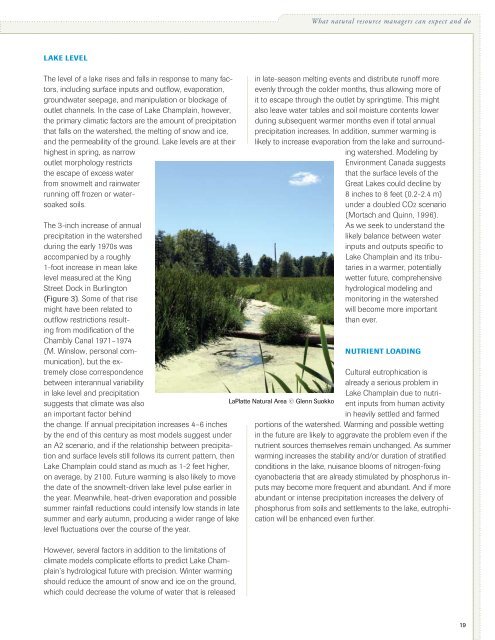Climate Change in the Champlain Basin - The Nature Conservancy
Climate Change in the Champlain Basin - The Nature Conservancy
Climate Change in the Champlain Basin - The Nature Conservancy
Create successful ePaper yourself
Turn your PDF publications into a flip-book with our unique Google optimized e-Paper software.
What natural resource managers can expect and doLake level<strong>The</strong> level of a lake rises and falls <strong>in</strong> response to many factors,<strong>in</strong>clud<strong>in</strong>g surface <strong>in</strong>puts and outflow, evaporation,groundwater seepage, and manipulation or blockage ofoutlet channels. In <strong>the</strong> case of Lake Champla<strong>in</strong>, however,<strong>the</strong> primary climatic factors are <strong>the</strong> amount of precipitationthat falls on <strong>the</strong> watershed, <strong>the</strong> melt<strong>in</strong>g of snow and ice,and <strong>the</strong> permeability of <strong>the</strong> ground. Lake levels are at <strong>the</strong>irhighest <strong>in</strong> spr<strong>in</strong>g, as narrowoutlet morphology restricts<strong>the</strong> escape of excess waterfrom snowmelt and ra<strong>in</strong>waterrunn<strong>in</strong>g off frozen or watersoakedsoils.<strong>The</strong> 3-<strong>in</strong>ch <strong>in</strong>crease of annualprecipitation <strong>in</strong> <strong>the</strong> watersheddur<strong>in</strong>g <strong>the</strong> early 1970s wasaccompanied by a roughly1-foot <strong>in</strong>crease <strong>in</strong> mean lakelevel measured at <strong>the</strong> K<strong>in</strong>gStreet Dock <strong>in</strong> Burl<strong>in</strong>gton(Figure 3). Some of that risemight have been related tooutflow restrictions result<strong>in</strong>gfrom modification of <strong>the</strong>Chambly Canal 1971–1974(M. W<strong>in</strong>slow, personal communication),but <strong>the</strong> extremelyclose correspondencebetween <strong>in</strong>terannual variability<strong>in</strong> lake level and precipitationsuggests that climate was alsoan important factor beh<strong>in</strong>d<strong>the</strong> change. If annual precipitation <strong>in</strong>creases 4–6 <strong>in</strong>chesby <strong>the</strong> end of this century as most models suggest underan A2 scenario, and if <strong>the</strong> relationship between precipitationand surface levels still follows its current pattern, <strong>the</strong>nLake Champla<strong>in</strong> could stand as much as 1-2 feet higher,on average, by 2100. Future warm<strong>in</strong>g is also likely to move<strong>the</strong> date of <strong>the</strong> snowmelt-driven lake level pulse earlier <strong>in</strong><strong>the</strong> year. Meanwhile, heat-driven evaporation and possiblesummer ra<strong>in</strong>fall reductions could <strong>in</strong>tensify low stands <strong>in</strong> latesummer and early autumn, produc<strong>in</strong>g a wider range of lakelevel fluctuations over <strong>the</strong> course of <strong>the</strong> year.However, several factors <strong>in</strong> addition to <strong>the</strong> limitations ofclimate models complicate efforts to predict Lake Champla<strong>in</strong>’shydrological future with precision. W<strong>in</strong>ter warm<strong>in</strong>gshould reduce <strong>the</strong> amount of snow and ice on <strong>the</strong> ground,which could decrease <strong>the</strong> volume of water that is released<strong>in</strong> late-season melt<strong>in</strong>g events and distribute runoff moreevenly through <strong>the</strong> colder months, thus allow<strong>in</strong>g more ofit to escape through <strong>the</strong> outlet by spr<strong>in</strong>gtime. This mightalso leave water tables and soil moisture contents lowerdur<strong>in</strong>g subsequent warmer months even if total annualprecipitation <strong>in</strong>creases. In addition, summer warm<strong>in</strong>g islikely to <strong>in</strong>crease evaporation from <strong>the</strong> lake and surround<strong>in</strong>gwatershed. Model<strong>in</strong>g byEnvironment Canada suggeststhat <strong>the</strong> surface levels of <strong>the</strong>Great Lakes could decl<strong>in</strong>e by8 <strong>in</strong>ches to 8 feet (0.2-2.4 m)under a doubled CO2 scenario(Mortsch and Qu<strong>in</strong>n, 1996).As we seek to understand <strong>the</strong>likely balance between water<strong>in</strong>puts and outputs specific toLake Champla<strong>in</strong> and its tributaries<strong>in</strong> a warmer, potentiallywetter future, comprehensivehydrological model<strong>in</strong>g andmonitor<strong>in</strong>g <strong>in</strong> <strong>the</strong> watershedwill become more importantthan ever.Nutrient load<strong>in</strong>gCultural eutrophication isalready a serious problem <strong>in</strong>Lake Champla<strong>in</strong> due to nutrient<strong>in</strong>puts from human activityLaPlatte Natural Area © Glenn Suokko<strong>in</strong> heavily settled and farmedportions of <strong>the</strong> watershed. Warm<strong>in</strong>g and possible wett<strong>in</strong>g<strong>in</strong> <strong>the</strong> future are likely to aggravate <strong>the</strong> problem even if <strong>the</strong>nutrient sources <strong>the</strong>mselves rema<strong>in</strong> unchanged. As summerwarm<strong>in</strong>g <strong>in</strong>creases <strong>the</strong> stability and/or duration of stratifiedconditions <strong>in</strong> <strong>the</strong> lake, nuisance blooms of nitrogen-fix<strong>in</strong>gcyanobacteria that are already stimulated by phosphorus <strong>in</strong>putsmay become more frequent and abundant. And if moreabundant or <strong>in</strong>tense precipitation <strong>in</strong>creases <strong>the</strong> delivery ofphosphorus from soils and settlements to <strong>the</strong> lake, eutrophicationwill be enhanced even fur<strong>the</strong>r.19
















